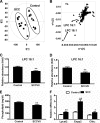Metabolomics reveals that tumor xenografts induce liver dysfunction
- PMID: 23637421
- PMCID: PMC3734574
- DOI: 10.1074/mcp.M113.028324
Metabolomics reveals that tumor xenografts induce liver dysfunction
Abstract
Metabolomics, based on ultraperformance liquid chromatography coupled with electrospray ionization quadrupole mass spectrometry, was used to explore metabolic signatures of tumor growth in mice. Urine samples were collected from control mice and mice injected with squamous cell carcinoma (SCCVII) tumor cells. When tumors reached ∼2 cm, all mice were killed and blood and liver samples collected. The urine metabolites hexanoylglycine, nicotinamide 1-oxide, and 11β,20α-dihydroxy-3-oxopregn-4-en-21-oic acid were elevated in tumor-bearing mice, as was asymmetric dimethylarginine, a biomarker for oxidative stress. Interestingly, SCCVII tumor growth resulted in hepatomegaly, reduced albumin/globulin ratios, and elevated serum triglycerides, suggesting liver dysfunction. Alterations in liver metabolites between SCCVII-tumor-bearing and control mice confirmed the presence of liver injury. Hepatic mRNA analysis indicated that inflammatory cytokines, tumor necrosis factor α, and transforming growth factor β were enhanced in SCCVII-tumor-bearing mice, and the expression of cytochromes P450 was decreased in tumor-bearing mice. Further, genes involved in fatty acid oxidation were decreased, suggesting impaired fatty acid oxidation in SCCVII-tumor-bearing mice. Additionally, activated phospholipid metabolism and a disrupted tricarboxylic acid cycle were observed in SCCVII-tumor-bearing mice. These data suggest that tumor growth imposes a global inflammatory response that results in liver dysfunction and underscore the use of metabolomics to temporally examine these changes and potentially use metabolite changes to monitor tumor treatment response.
Figures






Similar articles
-
Metabolic fate of 18F-FDG in mice bearing either SCCVII squamous cell carcinoma or C3H mammary carcinoma.J Nucl Med. 2002 Jul;43(7):940-7. J Nucl Med. 2002. PMID: 12097467
-
Enhancement of systemic tumor immunity for squamous cell carcinoma cells by an oncolytic herpes simplex virus.Cancer Gene Ther. 2013 Sep;20(9):493-8. doi: 10.1038/cgt.2013.45. Epub 2013 Jul 26. Cancer Gene Ther. 2013. PMID: 23887644
-
Effects of arachidonic acid metabolites in a murine model of squamous cell carcinoma.Head Neck. 2000 Mar;22(2):149-55. doi: 10.1002/(sici)1097-0347(200003)22:2<149::aid-hed6>3.0.co;2-t. Head Neck. 2000. PMID: 10679902
-
Control of steroid 21-oic acid synthesis by peroxisome proliferator-activated receptor alpha and role of the hypothalamic-pituitary-adrenal axis.J Biol Chem. 2010 Mar 5;285(10):7670-85. doi: 10.1074/jbc.M109.090175. Epub 2009 Dec 23. J Biol Chem. 2010. PMID: 20032461 Free PMC article.
-
Cooperation of liver cells in health and disease.Adv Anat Embryol Cell Biol. 2001;161:III-XIII, 1-151. doi: 10.1007/978-3-642-56553-3. Adv Anat Embryol Cell Biol. 2001. PMID: 11729749 Review.
Cited by
-
Bile acid signaling in lipid metabolism: metabolomic and lipidomic analysis of lipid and bile acid markers linked to anti-obesity and anti-diabetes in mice.Biochim Biophys Acta. 2015 Jan;1851(1):19-29. doi: 10.1016/j.bbalip.2014.04.008. Epub 2014 May 4. Biochim Biophys Acta. 2015. PMID: 24796972 Free PMC article.
-
PPARα-dependent exacerbation of experimental colitis by the hypolipidemic drug fenofibrate.Am J Physiol Gastrointest Liver Physiol. 2014 Sep 1;307(5):G564-73. doi: 10.1152/ajpgi.00153.2014. Epub 2014 Jul 17. Am J Physiol Gastrointest Liver Physiol. 2014. PMID: 25035112 Free PMC article.
-
Disrupted hepatic pentose phosphate pathway directly participates in and indirectly promotes CYP3A reduction: A new strategy for CYP3A-mediated drug hepatotoxicity.Br J Pharmacol. 2020 Apr;177(7):1538-1555. doi: 10.1111/bph.14916. Epub 2020 Jan 29. Br J Pharmacol. 2020. PMID: 31670839 Free PMC article.
-
LC-MS-based metabolomics: an update.Arch Toxicol. 2014 Aug;88(8):1491-502. doi: 10.1007/s00204-014-1234-6. Epub 2014 Apr 8. Arch Toxicol. 2014. PMID: 24710571 Free PMC article. Review.
-
Modulation of colon cancer by nutmeg.J Proteome Res. 2015 Apr 3;14(4):1937-46. doi: 10.1021/pr5013152. Epub 2015 Mar 10. J Proteome Res. 2015. PMID: 25712450 Free PMC article.
References
-
- Chen C., Krausz K. W., Shah Y. M., Idle J. R., Gonzalez F. J. (2009) Serum metabolomics reveals irreversible inhibition of fatty acid beta-oxidation through the suppression of PPARalpha activation as a contributing mechanism of acetaminophen-induced hepatotoxicity. Chem. Res. Toxicol. 22, 699–707 - PMC - PubMed
-
- Patterson A. D., Bonzo J. A., Li F., Krausz K. W., Eichler G. S., Aslam S., Tigno X., Weinstein J. N., Hansen B. C., Idle J. R., Gonzalez F. J. (2011) Metabolomics reveals attenuation of the SLC6A20 kidney transporter in nonhuman primate and mouse models of type 2 diabetes mellitus. J. Biol. Chem. 286, 19511–19522 - PMC - PubMed
-
- Monteiro M. S., Carvalho M., Bastos M. D., de Pinho P. G. (2013) Metabolomics analysis for biomarker discovery: advances and challenges. Curr. Med. Chem. 19, 5601–5606 - PubMed
Publication types
MeSH terms
Grants and funding
LinkOut - more resources
Full Text Sources
Other Literature Sources
Medical
Research Materials

